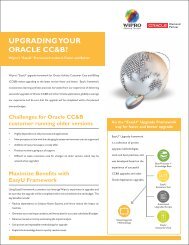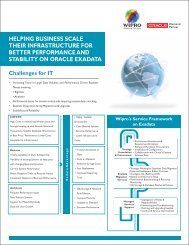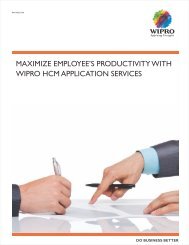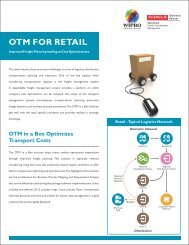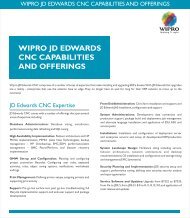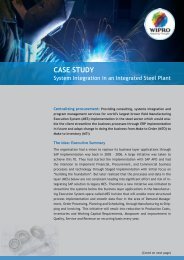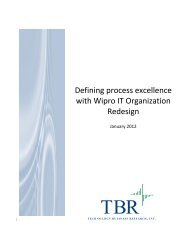Wipro Executive Summary
Wipro Executive Summary
Wipro Executive Summary
Create successful ePaper yourself
Turn your PDF publications into a flip-book with our unique Google optimized e-Paper software.
Reaping the Benefits of<br />
Cloud Computing
Contents<br />
Introduction .................................................................................................................................................. 2<br />
Finding #1: Better alignment between business and IT is a strategic objective for many companies. ........ 4<br />
Finding #2: A majority of organizations are either planning to include cloud computing as part of<br />
their firm’s IT strategy – or have already implemented a cloud computing model ..................................... 6<br />
Finding #3: Reducing capital expenditure and maintenance costs is the key goal and objective for<br />
many organization’s cloud computing initiatives. ........................................................................................ 8<br />
Finding #4: Most survey respondents have invested in capacity expansion over the past three years. ... 10<br />
Finding #5: Data security is an important concern for most organizations. …………………….………..13<br />
Conclusion …………………………………………………………………………………………………….……………….………..16
Reaping the Benefits of Cloud Computing<br />
Introduction:<br />
In the current business environment, organizations are mandated to run lean and mean,<br />
holding down costs while maximizing the resources they have. Organizations must also hone<br />
their competitive edge with the ability to quickly deliver new products to market. An agile IT<br />
environment with operational flexibility can go a long way in helping companies successfully<br />
compete in the today’s highly-charged economic environment.<br />
Cloud computing, an Internet-based model for IT services consumption, supplementation and<br />
delivery, can be instrumental in assisting companies in dealing with today’s most pressing<br />
issues. It typically involves providing dynamically scalable and often virtualized resources as a<br />
service over the Internet. Cloud computing providers normally deliver business applications<br />
online, making them readily available via a Web browser. Software and data are stored on<br />
servers.<br />
Because they only pay for what they actually use, organizations that implement the cloud<br />
computing model avoid the substantial upfront investment in hardware, software and related<br />
services. Resource consumption is typically billed or available by subscription. Cloud’s many<br />
benefits include dramatically reduced costs, low management and maintenance requirements,<br />
and immediate access to a variety of applications.<br />
In addition, cloud delivers computing capacity to organizations quickly and on an as-needed<br />
basis. Conversely, cloud can enable organizations to scale back as their business needs change.<br />
This ‘elasticity’ is an important feature for organizations that don’t want to commit to the full<br />
capacity they want today but desire to stay poised for the future ebb and flow of business<br />
demands.<br />
Cloud’s major benefits include:<br />
• Agility, since users can quickly and inexpensively provision infrastructure resources on an asneeded<br />
basis;<br />
• Reduced cost, lowering barriers to entry and making it unnecessary for firms to make major<br />
investments in infrastructure;<br />
• Anytime/Anywhere access, because services are delivered over the Internet;<br />
3 | P a g e
Reaping the Benefits of Cloud Computing<br />
• Scalability, which enables users to ramp up in times of greater demand, and scale down when<br />
demand abates;<br />
• Reliability, due to cloud computing delivery using multiple sites;<br />
• Sustainability, from improved resource utilization and more efficient systems; and<br />
• Lower maintenance, since applications are not installed on every computer in an<br />
organization.<br />
Outsourcing Center and <strong>Wipro</strong> performed a survey that aimed to determine views and opinions<br />
on cloud computing of companies from various industry segments. While not a comprehensive<br />
picture of how these organizations are approaching cloud computing, the survey results identify<br />
some general trends in this emerging area. Survey respondents were from retail, financial<br />
services, transportation/logistics, manufacturing, healthcare, telecommunications and other<br />
industries.<br />
How does cloud computing fit into your company’s overall IT strategy?<br />
4 | P a g e
Reaping the Benefits of Cloud Computing<br />
Finding #1: Better alignment between business and IT is the number one<br />
strategic IT objective for many companies.<br />
What are your strategic IT objectives?<br />
Better business-IT alignment<br />
Cost reduction<br />
Increased availability and reliability<br />
Outsourcing<br />
Other<br />
Today's business organizations are increasingly reliant on IT to achieve business growth and<br />
drive innovation in their processes. Given the turbulent economy and increasing pressures to<br />
reduce costs and use fewer resources while meeting tighter deadlines, it’s become imperative<br />
for IT to be more agile in responding to business opportunities and for IT managers to drive<br />
innovation. Organizations that are able to align business and IT will be more efficient and<br />
effective in delivering products and services. They will also excel in lowering costs while<br />
increasing opportunity for new revenue and product opportunities.<br />
Given this scenario, it is expected that in the near future almost all IT infrastructure layers will<br />
be more directly driven by business processes. Enterprises have started to seriously consider<br />
cloud computing as an answer to challenges ranging from managing the enterprise IT<br />
infrastructure economically to improving employee productivity.<br />
Cloud computing enables businesses to reduce costs and improve service levels. A major aspect<br />
of on-demand cloud computing is that it helps companies to respond with flexibility and speed<br />
to any customer demand, market opportunity or external threat. Furthermore, cloud<br />
11%<br />
31%<br />
42%<br />
51%<br />
57%<br />
5 | P a g e
Reaping the Benefits of Cloud Computing<br />
computing enables customers to access all of their documents and data from any device (the<br />
home or work PC, the mobile phone, an internet point), as they already do for email services or<br />
social networks – thus enhancing business efficiency.<br />
According to the <strong>Wipro</strong> and Outsourcing Center survey, a majority of firms are striving to more<br />
closely align business and IT functions. In fact, more than half (56.7%) of respondents said that<br />
better business-IT alignment was among their strategic IT objectives. Also important to survey<br />
respondents is reducing costs, as 51.1 percent of participants identified cost reduction as a<br />
strategic IT objective. Respondents also said their companies were interested in increasing<br />
availability and reliability (42.2%) and outsourcing (31.1%).<br />
Says RamPrasad Kan, Chief Technologist at <strong>Wipro</strong> Technologies, other considerations are<br />
important as well. “In this market, cost savings and resource optimization are critical,” says Kan.<br />
“For lines of business, a top priority is the ability to quickly bring new products and services to<br />
market. And cloud can deliver all these benefits.”<br />
6 | P a g e
Reaping the Benefits of Cloud Computing<br />
Finding #2: A majority of organizations are either planning to include cloud<br />
computing as part of their firm’s IT strategy – or have already implemented a<br />
cloud computing model.<br />
Is cloud computing part of your current IT strategy? OR Have you<br />
implemented cloud computing?<br />
No<br />
29%<br />
Cloud computing is a model that’s beginning to enjoy widespread adoption. The majority of<br />
<strong>Wipro</strong>-Outsourcing Center survey respondents report that they are either now including cloud<br />
computing in their current IT strategy, or they’ve used it in the past. In fact, nearly threefourths<br />
(71.4%) of survey participants are currently using cloud computing or have used it<br />
previously. Only just more than one-fourth (28.6%) are not now using cloud and have not used<br />
this model in the past.<br />
The benefits of cloud computing are many, but optimization of resource utilization was the<br />
reason half of survey respondents said that they chose it.<br />
• Less than one-fifth (19.7%) of respondents said that cloud’s cost advantage was the number<br />
one reason they chose this model.<br />
• Only 9.1 percent said that simplified usage for end users was their reason for going with<br />
cloud.<br />
71%<br />
Yes<br />
7 | P a g e
Reaping the Benefits of Cloud Computing<br />
• A scant 3.0 percent cited remote access through the Internet as their reason for<br />
implementing cloud computing.<br />
• Almost half (47.3%) of survey participants said that cloud computing is central to their overall<br />
IT strategy.<br />
For the most part, those whose organizations haven’t implemented cloud computing said that<br />
their hesitance was due to the immaturity of the cloud computing model, or that they weren’t<br />
sufficiently informed of the real benefits that cloud computing could deliver to their<br />
organization. Others are considering implementing the cloud computing model in the future.<br />
According to <strong>Wipro</strong>’s Kan, firms that haven’t yet looked to cloud computing might want to revisit<br />
their strategy.<br />
“Most companies already are adopting cloud in some manner because the benefits seem to be<br />
very obvious, and they were waiting for the early adopters who have been using cloud for a<br />
while now,” he points out. “So companies are now implementing cloud at an impressive rate.”<br />
Cloud computing services include: Infrastructure as a Service (IaaS), which provides virtual<br />
servers with unique IP addresses and blocks of storage on demand; Platform as a Service (PaaS),<br />
a group of software and development tools that are hosted on the service provider’s servers;<br />
and Software as a Service (SaaS), where the outside vendor provides access to a wide variety of<br />
applications.<br />
Says Kan, small and large businesses generally differ in their cloud usage. A small business<br />
wants to take everything from the cloud – infrastructure, platform and applications, he says.<br />
“But most large enterprises will go the hybrid route, with some things in-house and others from<br />
the cloud, while smaller businesses will take advantage of the entire stack of offerings from the<br />
public cloud.”<br />
8 | P a g e
Reaping the Benefits of Cloud Computing<br />
Finding #3: Reducing capital expenditure and maintenance costs is the key goal<br />
and objective for many organization’s cloud computing initiatives.<br />
What are the three key goals and objectives for your current or planned<br />
cloud computing initiative?<br />
Reduced Capital Expenditure and<br />
maintenance costs<br />
Better pooling of resources and<br />
superior performance<br />
Increased availability<br />
Other<br />
Cloud computing provides enterprises a choice of a subscription payment model or migration of<br />
their multiple workloads onto shared IT infrastructures, either private or public clouds. In<br />
financial terms, this enables a company to be cost efficient by transforming the bulk of its<br />
infrastructure costs from being a capital expenditure to an operating expenditure, while<br />
simultaneously achieving high levels of consolidation and IT automation.<br />
By offering self-service system interfaces to the users, cloud computing simplifies system<br />
usability. Customers are freed from the hassles associated with developing applications, backend<br />
engineering and maintaining the server. In short, users just pay and use the application<br />
services without having to bother with operation, software maintenance or application support<br />
functions. This further helps reduce costs.<br />
In addition, cloud computing is based on an integrated platform of infrastructure, platform and<br />
software, resulting in economies of resources and costs. Pooling resources by multiple<br />
companies leads to superior performance of the complete system. The load is effectively<br />
managed from a single central source and the server uses full capacity. This is a win-win<br />
situation for both the host and the users. Thus, cloud computing results in improved resource<br />
consumption and is extremely cost effective.<br />
24%<br />
44%<br />
60%<br />
75%<br />
9 | P a g e
Reaping the Benefits of Cloud Computing<br />
In the <strong>Wipro</strong> and Outsourcing Center survey, a full three-fourths of responding organizations<br />
noted the most important objective for their current or planned cloud computing initiative is<br />
reducing capital expenditure and maintenance costs. More than half (59.7%) identified better<br />
pooling of resources and superior performance as key objectives. And increased availability was<br />
also flagged as a key goal for organizations’ cloud efforts.<br />
“Cloud can help ensure that organizations have an agile IT environment with true operational<br />
flexibility,” Kan explains. “And savings can be considerable with the cloud computing model.”<br />
But cloud can also deliver best-of-breed applications, apps that CIOs want to deploy but don’t<br />
want to spend a lot of time developing. “Firms can get these applications from a cloud service<br />
provider without having to develop them and without having to manage them. With cloud, you<br />
don’t have to manage the infrastructure in a discrete manner. Instead, you can consolidate and<br />
optimize your infrastructure very effectively,” says Kan.<br />
10 | P a g e
Reaping the Benefits of Cloud Computing<br />
Finding #4: Most survey respondents have invested in capacity expansion over<br />
the past three years.<br />
Have you invested in capacity expansion over the past three years?<br />
No<br />
15%<br />
Due to the rapid growth in services, it has become vital for companies to scale up their IT<br />
infrastructure and invest in capacity expansion to meet increasing customer demands.<br />
Companies need a cost-effective way to achieve this objective without risking over<br />
provisioning their networks or data centers.<br />
For instance, when enterprises have expansion plans across geographies or growth of business<br />
units, they automatically need a big IT back end. In addition, the huge backlog of data<br />
accumulated in the process would require a heavy IT infrastructure investment to sufficiently<br />
process and store that massive data, while still being able to offer effective services to<br />
customers.<br />
Shifting to the cloud can enable the organization to host data on an external platform while<br />
still providing the necessary services to customers. Also in situations where there is a shortterm<br />
requirement that heavily relies on a large IT back end, a company can opt for a cloud<br />
rather than investing unjustified sums to acquire new infrastructure for a short-lived need.<br />
85%<br />
Yes<br />
11 | P a g e
Reaping the Benefits of Cloud Computing<br />
Cloud computing provides the resources on-demand for many typical scaling points that a Web<br />
application needs, including servers, storage and networking. The on-demand nature of cloud<br />
computing combined with the pay-as-you-go model means that when a company requires<br />
more capacity during a peak season or to match its growth, it simply pays for it on demand.<br />
Similarly, when a business slows down and a company needs less capacity, it just uses (and<br />
pays) for the resources as required. In a nutshell, cloud offers nearly unlimited capacity and<br />
agility giving enterprises the ability to add or subtract servers while taking advantage of the<br />
cloud’s on-demand pricing. Cloud computing can enable enterprises to deploy on-demand<br />
scaling according to the fluctuation of business traffic.<br />
An overwhelming majority of respondents to the <strong>Wipro</strong> and Outsourcing Center survey said<br />
that their organizations had invested in capacity expansion over the past three years.<br />
84.6 percent said that their organizations had invested in capacity expansion over the past<br />
three years<br />
15.4 percent had not invested in capacity expansion<br />
25 percent said that their firm’s current IT infrastructure utilization rates were less than 30<br />
percent<br />
34.2 percent said their firm’s IT infrastructure utilization rates were in the 30 percent to 50<br />
percent range.<br />
40.8 percent of respondents said that in their firm, these rates were in the 50 percent to 75<br />
percent range.<br />
Capacity management impacts all IT organizations. It’s critical to predict the kind of demand<br />
users typically face and also have the ability to increase capacity as quickly as possible.<br />
12 | P a g e
Reaping the Benefits of Cloud Computing<br />
“Speed has become the top-of-mind advantage today,” Kan says. “The faster you can deliver<br />
capacity to business, the easier you can innovate, introduce new services and take a new<br />
product or service to market.”<br />
To get computer capacity for a project team may involve a 45-day cycle. With cloud, the cycle<br />
time is reduced to a mere 45 minutes. “With cloud, users can log in and get the capacity they<br />
need. And in addition, organizations add more control to their IT infrastructure,” Kan notes.<br />
13 | P a g e
Reaping the Benefits of Cloud Computing<br />
Finding #5: Data security is a big concern for most organizations.<br />
How much importance do you place on data security? Rate on a scale<br />
from 1 to 5 where 1 is very important and 5 is not important.<br />
3<br />
2<br />
4<br />
3%<br />
14%<br />
14%<br />
5<br />
9%<br />
There are several security concerns that have been raised related to cloud computing.<br />
However, these issues can be managed competently with effective data safeguarding<br />
measures in the cloud.<br />
According to Gartner, Cloud computing has "unique attributes that require risk assessment in<br />
areas such as data integrity, recovery and privacy, and an evaluation of legal issues in areas<br />
such as e-discovery, regulatory compliance and auditing." It is important for cloud providers to<br />
ensure greater control of hosting and accessing services and applications in the cloud. By<br />
taking on this significant responsibility, they will be able to assure customers of data security in<br />
the cloud.<br />
Cloud providers should follow similar protection measures for cloud infrastructure security as<br />
they do for their physical assets in their internal data center. All data access in the cloud<br />
should be mediated through a proactive security control that can monitor and block malicious<br />
or inappropriate use. Firewalls and data leakage prevention appliances can be applied in a<br />
virtual environment to monitor and maintain the same level of security. The standard defense<br />
60%<br />
1<br />
14 | P a g e
Reaping the Benefits of Cloud Computing<br />
– an in-depth approach of deploying multiple technologies to detect and defend against<br />
attacks on sensitive data – is essential.<br />
Cloud providers should also have an appropriate disaster recovery and business continuity<br />
processes in place to meet customers’ business needs. With a disaster recovery plan, vendors<br />
can replicate the data and application infrastructure across multiple sites in the case of a<br />
failure, providing customers with the necessary data backup.<br />
Regulatory compliance is another important aspect that providers need to fulfill. The cloud<br />
provider must have the necessary policies, processes and procedures in place to properly<br />
maintain those security controls. These principles should ensure that there is transparency<br />
over how data is protected. Cloud providers should maintain a comprehensive security<br />
program and should disclose whether their security efforts meet security standards.<br />
In a nutshell, vendors need to have these security steps in place and follow a transparency<br />
approach with customers. In this way, customers are aware of the data assets they are putting<br />
into a cloud and can work together with the vendor to ensure the control policies match the<br />
legal requirements of that data and ensure they are able to reclaim their documents and data<br />
in the case of a security attack.<br />
Nearly three-fourths (74.4%) of all respondents to the <strong>Wipro</strong>-Outsourcing Center survey said<br />
that data security was either a major concern or of considerable importance for their<br />
organization. Only 14.1 percent said that data security was not important for their firm.<br />
Security concerns vary depending on the type of cloud used by an organization. Services<br />
delivered via Public Cloud are provided over the Internet through a Web application or Web<br />
services from an off-site, third-party provider. A private cloud emulates cloud computing but<br />
actually delivers services through private networks. Private clouds provide a greater level of<br />
security. Many organizations use what are called hybrid clouds. A hybrid cloud environment<br />
uses multiple and internal and external providers, or public and private clouds, enabling<br />
15 | P a g e
Reaping the Benefits of Cloud Computing<br />
enterprises to receive less sensitive information and services through the public cloud and<br />
their more sensitive information through a private cloud.<br />
Explains <strong>Wipro</strong>’s Kan, the data security issue can be handled with a combination of technology<br />
and process. “There are processes that must be put in place before an enterprise can adopt a<br />
public cloud and manage the data efficiently,” he points out. “These are the kind of services<br />
<strong>Wipro</strong> can provide in terms of determining how a public cloud is being used by an enterprise,<br />
monitoring on a continuous basis and assuring that data is secure and not left open.”<br />
Conclusion:<br />
Cloud computing can provide benefits to organizations of all sizes and from all industry<br />
segments. Cloud’s many benefits include agility, reduced cost, access to services anytime,<br />
anywhere; scalability that enables users to ramp up – or down – as demand surges or wanes;<br />
and lower maintenance requirements. Cloud enables optimization of resources and<br />
unprecedented speed in increasing computer capacity, enabling businesses to innovate and<br />
get products to market in a timely manner.<br />
<strong>Wipro</strong>’s solutions and services extend across the various cloud layers, from Business Process as<br />
a Service, Software as a Service, and Platform as a Service to Infrastructure as a Service.<br />
Whatever the client’s strategy for cloud adoption, <strong>Wipro</strong> has the expertise, experience and<br />
integrated solutions to match clients’ requirements.<br />
<strong>Wipro</strong> believes that enterprise IT -- applications, platforms, infrastructure, business process --<br />
will be a hybrid of traditional on-premise , private cloud and public cloud services. Enterprises<br />
will potentially consume cloud services from multiple public cloud service providers and also<br />
consolidate internally through private clouds. <strong>Wipro</strong>'s is a trusted partner able to integrate<br />
public and private cloud services for an enterprise to create an agile and business-oriented IT.<br />
<strong>Wipro</strong> can also create a portfolio of industry-specific business process solutions delivered as<br />
cloud services from public cloud platforms and its own data centers.<br />
<strong>Wipro</strong>’s cloud services portfolio helps address two key customer objectives:<br />
Build, operate and manage enterprise private cloud environments<br />
Adopt hybrid cloud delivery models by helping customers integrate cloud services into<br />
their IT portfolio and manage IT as a service for on- and off-premise infrastructure and<br />
applications<br />
16 | P a g e
Reaping the Benefits of Cloud Computing<br />
<strong>Wipro</strong> offers a portfolio of <strong>Wipro</strong>-branded cloud services to its customers, catering to both<br />
horizontal and industry-specific applications. <strong>Wipro</strong>’s services ride on a strong R&D backbone<br />
consisting of 18 cloud centers of excellence, ably supported by a robust partner ecosystem<br />
integrating best-of-breed cloud solutions from key industry players. The firm’s unique, nonintrusive<br />
cloud discovery consulting service, combined with replicable solutions and<br />
frameworks, have made <strong>Wipro</strong> the partner of choice for more than 150 cloud customers<br />
around the world. Driven by a strong global presence and with established practices across<br />
various industry verticals, <strong>Wipro</strong> helps organizations adopt cloud dynamically, effectively and in<br />
a scalable and sustainable model.<br />
About the Survey Respondents:<br />
A full 40 percent of survey participants are employed at firms with fewer than 1,000 employees.<br />
More than a third (36.7%) work for large enterprises with more than 20,000 people employed.<br />
The remaining 22.4 percent said their firms employed more than 1,000 individuals but fewer<br />
than 20,000 people. More than half (50.6%) of respondents said their company’s annual<br />
revenue is greater than $300 million, while just more than one-quarter (27.5%) of participants<br />
said their firm’s annual revenue is less than $20 million. More than half (56.8%) of survey<br />
participants responded that their IT budget for 2009 was more than $10 million, with 42.0<br />
percent of respondents’ companies operating with an IT budget of more than $50 million for<br />
the past year.<br />
ABOUT WIPRO TECHNOLOGIES<br />
<strong>Wipro</strong> is the first PCMM Level 5 and SEI CMMi Level 5 certified IT Services Company globally.<br />
<strong>Wipro</strong> provides comprehensive IT solutions and services (including systems integration, IS<br />
outsourcing, package implementation, software application development and maintenance)<br />
and Research & Development services (hardware and software design, development and<br />
implementation) to corporations globally.<br />
<strong>Wipro</strong>'s unique value proposition is further delivered through its pioneering Offshore<br />
Outsourcing Model and stringent Quality Processes of SEI and Six Sigma.<br />
17 | P a g e
Reaping the Benefits of Cloud Computing<br />
ABOUT WIPRO Council for Industry Research<br />
The <strong>Wipro</strong> Council for Industry Research comprising of domain and technology experts from<br />
the organization aims to address the needs of customers by specifically looking at innovative<br />
strategies that will help them gain competitive advantage in the market. The Council, in<br />
collaboration with leading academic institutions and industry bodies, studies market trends to<br />
equip organizations with insights that facilitate their IT and business strategies<br />
For more information please visit www.wipro.com/industryresearch.<br />
ABOUT Outsourcing Center<br />
Outsourcing Center is the most prominent Internet portal for thought leadership, best<br />
practices, emerging trends, and strategies for successful sourcing. In addition, since 1997 we<br />
have recognized the world’s best outsourcing relationships through the annual Outsourcing<br />
Excellence Awards program. As the resource for actionable business insights, Outsourcing<br />
Center provides objective perspectives and real-world examples, identifies business risks, and<br />
explains how to leverage value-creation opportunities. The Center’s parent company is Everest<br />
Group, an advisor to business leaders on global services with a worldwide reputation for<br />
helping Global 1000 firms dramatically improve their performance by optimizing their back- and<br />
middle-office business services. For more information, contact Peter Bowes at<br />
pbowes@outsourcingcenter.com<br />
18 | P a g e




